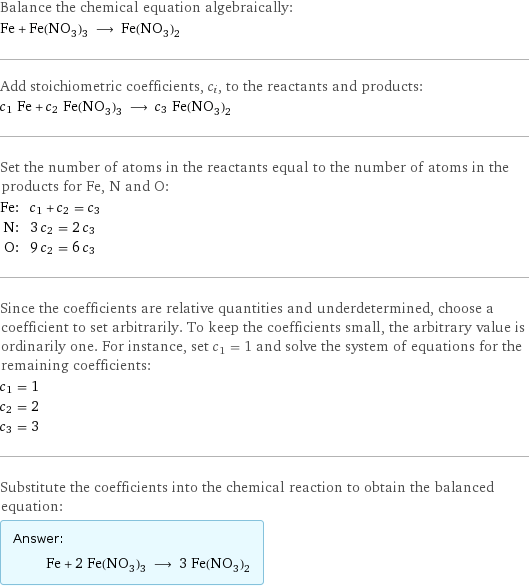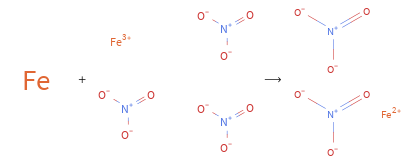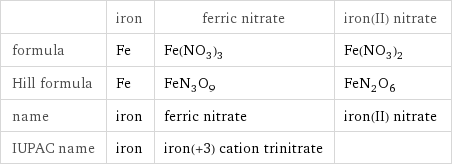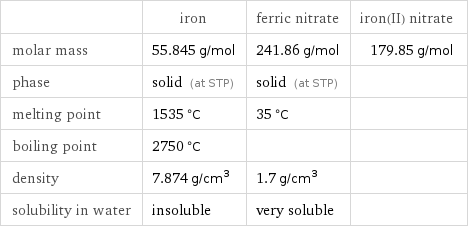Input interpretation

Fe iron + Fe(NO_3)_3 ferric nitrate ⟶ Fe(NO_3)_2 iron(II) nitrate
Balanced equation

Balance the chemical equation algebraically: Fe + Fe(NO_3)_3 ⟶ Fe(NO_3)_2 Add stoichiometric coefficients, c_i, to the reactants and products: c_1 Fe + c_2 Fe(NO_3)_3 ⟶ c_3 Fe(NO_3)_2 Set the number of atoms in the reactants equal to the number of atoms in the products for Fe, N and O: Fe: | c_1 + c_2 = c_3 N: | 3 c_2 = 2 c_3 O: | 9 c_2 = 6 c_3 Since the coefficients are relative quantities and underdetermined, choose a coefficient to set arbitrarily. To keep the coefficients small, the arbitrary value is ordinarily one. For instance, set c_1 = 1 and solve the system of equations for the remaining coefficients: c_1 = 1 c_2 = 2 c_3 = 3 Substitute the coefficients into the chemical reaction to obtain the balanced equation: Answer: | | Fe + 2 Fe(NO_3)_3 ⟶ 3 Fe(NO_3)_2
Structures

+ ⟶
Names

iron + ferric nitrate ⟶ iron(II) nitrate
Equilibrium constant
![Construct the equilibrium constant, K, expression for: Fe + Fe(NO_3)_3 ⟶ Fe(NO_3)_2 Plan: • Balance the chemical equation. • Determine the stoichiometric numbers. • Assemble the activity expression for each chemical species. • Use the activity expressions to build the equilibrium constant expression. Write the balanced chemical equation: Fe + 2 Fe(NO_3)_3 ⟶ 3 Fe(NO_3)_2 Assign stoichiometric numbers, ν_i, using the stoichiometric coefficients, c_i, from the balanced chemical equation in the following manner: ν_i = -c_i for reactants and ν_i = c_i for products: chemical species | c_i | ν_i Fe | 1 | -1 Fe(NO_3)_3 | 2 | -2 Fe(NO_3)_2 | 3 | 3 Assemble the activity expressions accounting for the state of matter and ν_i: chemical species | c_i | ν_i | activity expression Fe | 1 | -1 | ([Fe])^(-1) Fe(NO_3)_3 | 2 | -2 | ([Fe(NO3)3])^(-2) Fe(NO_3)_2 | 3 | 3 | ([Fe(NO3)2])^3 The equilibrium constant symbol in the concentration basis is: K_c Mulitply the activity expressions to arrive at the K_c expression: Answer: | | K_c = ([Fe])^(-1) ([Fe(NO3)3])^(-2) ([Fe(NO3)2])^3 = ([Fe(NO3)2])^3/([Fe] ([Fe(NO3)3])^2)](../image_source/e5b7ddb66b8289efaf073c5514c14ad6.png)
Construct the equilibrium constant, K, expression for: Fe + Fe(NO_3)_3 ⟶ Fe(NO_3)_2 Plan: • Balance the chemical equation. • Determine the stoichiometric numbers. • Assemble the activity expression for each chemical species. • Use the activity expressions to build the equilibrium constant expression. Write the balanced chemical equation: Fe + 2 Fe(NO_3)_3 ⟶ 3 Fe(NO_3)_2 Assign stoichiometric numbers, ν_i, using the stoichiometric coefficients, c_i, from the balanced chemical equation in the following manner: ν_i = -c_i for reactants and ν_i = c_i for products: chemical species | c_i | ν_i Fe | 1 | -1 Fe(NO_3)_3 | 2 | -2 Fe(NO_3)_2 | 3 | 3 Assemble the activity expressions accounting for the state of matter and ν_i: chemical species | c_i | ν_i | activity expression Fe | 1 | -1 | ([Fe])^(-1) Fe(NO_3)_3 | 2 | -2 | ([Fe(NO3)3])^(-2) Fe(NO_3)_2 | 3 | 3 | ([Fe(NO3)2])^3 The equilibrium constant symbol in the concentration basis is: K_c Mulitply the activity expressions to arrive at the K_c expression: Answer: | | K_c = ([Fe])^(-1) ([Fe(NO3)3])^(-2) ([Fe(NO3)2])^3 = ([Fe(NO3)2])^3/([Fe] ([Fe(NO3)3])^2)
Rate of reaction
![Construct the rate of reaction expression for: Fe + Fe(NO_3)_3 ⟶ Fe(NO_3)_2 Plan: • Balance the chemical equation. • Determine the stoichiometric numbers. • Assemble the rate term for each chemical species. • Write the rate of reaction expression. Write the balanced chemical equation: Fe + 2 Fe(NO_3)_3 ⟶ 3 Fe(NO_3)_2 Assign stoichiometric numbers, ν_i, using the stoichiometric coefficients, c_i, from the balanced chemical equation in the following manner: ν_i = -c_i for reactants and ν_i = c_i for products: chemical species | c_i | ν_i Fe | 1 | -1 Fe(NO_3)_3 | 2 | -2 Fe(NO_3)_2 | 3 | 3 The rate term for each chemical species, B_i, is 1/ν_i(Δ[B_i])/(Δt) where [B_i] is the amount concentration and t is time: chemical species | c_i | ν_i | rate term Fe | 1 | -1 | -(Δ[Fe])/(Δt) Fe(NO_3)_3 | 2 | -2 | -1/2 (Δ[Fe(NO3)3])/(Δt) Fe(NO_3)_2 | 3 | 3 | 1/3 (Δ[Fe(NO3)2])/(Δt) (for infinitesimal rate of change, replace Δ with d) Set the rate terms equal to each other to arrive at the rate expression: Answer: | | rate = -(Δ[Fe])/(Δt) = -1/2 (Δ[Fe(NO3)3])/(Δt) = 1/3 (Δ[Fe(NO3)2])/(Δt) (assuming constant volume and no accumulation of intermediates or side products)](../image_source/a5252726bd146a5f0ab024775a7d107e.png)
Construct the rate of reaction expression for: Fe + Fe(NO_3)_3 ⟶ Fe(NO_3)_2 Plan: • Balance the chemical equation. • Determine the stoichiometric numbers. • Assemble the rate term for each chemical species. • Write the rate of reaction expression. Write the balanced chemical equation: Fe + 2 Fe(NO_3)_3 ⟶ 3 Fe(NO_3)_2 Assign stoichiometric numbers, ν_i, using the stoichiometric coefficients, c_i, from the balanced chemical equation in the following manner: ν_i = -c_i for reactants and ν_i = c_i for products: chemical species | c_i | ν_i Fe | 1 | -1 Fe(NO_3)_3 | 2 | -2 Fe(NO_3)_2 | 3 | 3 The rate term for each chemical species, B_i, is 1/ν_i(Δ[B_i])/(Δt) where [B_i] is the amount concentration and t is time: chemical species | c_i | ν_i | rate term Fe | 1 | -1 | -(Δ[Fe])/(Δt) Fe(NO_3)_3 | 2 | -2 | -1/2 (Δ[Fe(NO3)3])/(Δt) Fe(NO_3)_2 | 3 | 3 | 1/3 (Δ[Fe(NO3)2])/(Δt) (for infinitesimal rate of change, replace Δ with d) Set the rate terms equal to each other to arrive at the rate expression: Answer: | | rate = -(Δ[Fe])/(Δt) = -1/2 (Δ[Fe(NO3)3])/(Δt) = 1/3 (Δ[Fe(NO3)2])/(Δt) (assuming constant volume and no accumulation of intermediates or side products)
Chemical names and formulas

| iron | ferric nitrate | iron(II) nitrate formula | Fe | Fe(NO_3)_3 | Fe(NO_3)_2 Hill formula | Fe | FeN_3O_9 | FeN_2O_6 name | iron | ferric nitrate | iron(II) nitrate IUPAC name | iron | iron(+3) cation trinitrate |
Substance properties

| iron | ferric nitrate | iron(II) nitrate molar mass | 55.845 g/mol | 241.86 g/mol | 179.85 g/mol phase | solid (at STP) | solid (at STP) | melting point | 1535 °C | 35 °C | boiling point | 2750 °C | | density | 7.874 g/cm^3 | 1.7 g/cm^3 | solubility in water | insoluble | very soluble |
Units
